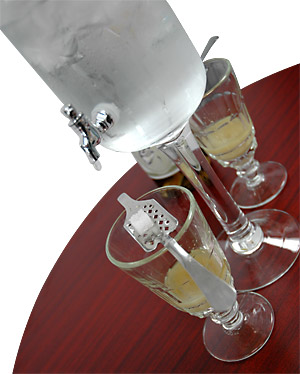
On Trial
In the latter part of the 19th Century, French wine growers faced declining wine production in the wake of an insect infestation that decimated crops. Absinthe gained popularity in the vacuum created by the absence of wine. Attempting to recover from disaster, the wine industry sought demonize absinthe, saying that it made homicidal maniacs of men and turned God-fearing women into harlots.
The coup de grace came during the famous case of a Swiss man named Mr. Jean Lanfray, who was convicted of murdering his pregnant wife and two children. Police revealed that Mr. Lanfray had consumed 7 glasses of wine, 2 crème de menthes, 6 glasses of cognac, and a coffee laced with brandy – along with two ounces of absinthe. The trial lasted a single day and by dusk, the murders were solely blamed on the influence of absinthe. (Clearly the excessive wine and
Here is a short list of world renowned artists who reportedly indulged in absinthe. Is there a link between consumption and artistic expression? You decide.
liquor had nothing to do with it.). What followed in the wake of such “evidence” led to a complete ban on absinthe in many countries.
Dispelling Myth
As an element of propaganda, absinthe was reported to be a hallucinogen and had an ill-gotten reputation for causing insanity. The fact is absinthe does not cause hallucinations. Reports of hallucinations are likely the result of poor quality materials and the results of contamination –including heavy metals (which can be poisonous and cause hallucinations). After all, with absinthe becoming increasingly popular in the absence of wine, everyone wanted in on the business. Not all absinthe producers were legit and many inferior (and sometimes deadly) products were available in the high-demand market of absinthe production.
It was once believed that Vincent Van Gogh had lobbed off his famous ear as a result of absinthe consumption. This rather hysterical notion fades into obscurity since we now understand that Van Gogh suffered from bipolar disorder, amongst other mental conditions. (So much for absinthe being the cause of insanity.)
 Thujone, the chemical compound found in wormwood is not a cannabinoid, nor is it related to cannabis. This assumption was originally made because the chemical structure of thujone closely resembles that of THC (or tetrahydrocannabinol– which is the psychoactive chemical found in cannabis). As anyone who knows the difference between a duck and a goose can tell you, just because they appear to be the same, doesn’t mean they are the same. Thujone's psychedelic and psychoactive effects, if any, are minuscule at best. Modern absinthes, depending on the country of origin, have little or no thujone and are highly regulated in many countries. Some myths never die.
Thujone, the chemical compound found in wormwood is not a cannabinoid, nor is it related to cannabis. This assumption was originally made because the chemical structure of thujone closely resembles that of THC (or tetrahydrocannabinol– which is the psychoactive chemical found in cannabis). As anyone who knows the difference between a duck and a goose can tell you, just because they appear to be the same, doesn’t mean they are the same. Thujone's psychedelic and psychoactive effects, if any, are minuscule at best. Modern absinthes, depending on the country of origin, have little or no thujone and are highly regulated in many countries. Some myths never die.
Reported states of heightened lucidity have been reported during absinthe consumption – which is likely the result of the herbs used in production. Some herbs have calming effects, while others have stimulating effects. In fact, some of the herbs in absinthe also have anti-parasitic and even painkilling properties.
Looking Forward
Many may dismiss the reemergence of absinthe as mere trend, as the latest flavor of the week. Others will embrace it openly.
Regardless of modern acceptance, absinthe will continue to be a waypoint in our history, representing a period of time when our eyes were opened and we looked into the future with inquisitive, optimistic eyes; when we peered from behind the curtains of obscurity and uncovered the truths about our existence and our perceptions of the universe in which we live. We breathed a life into our arts and stepped bravely into the future.



Leave a Comment